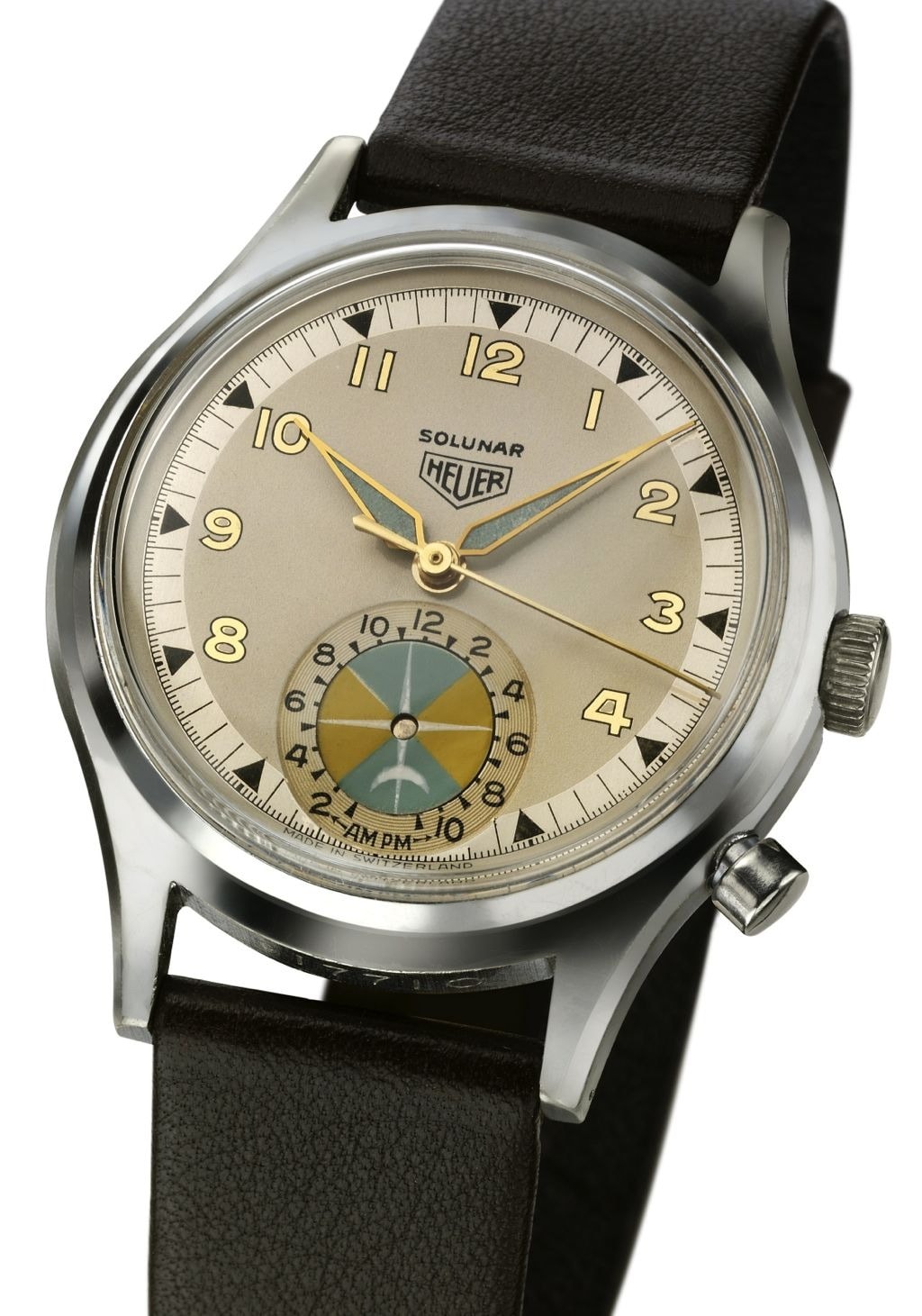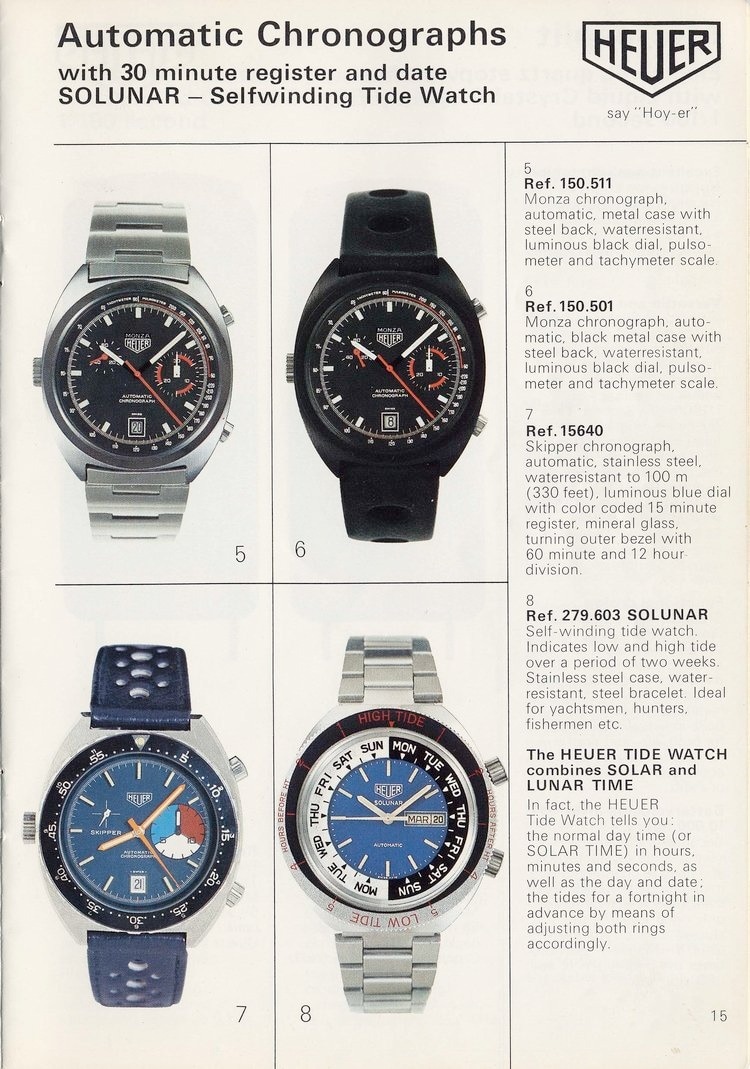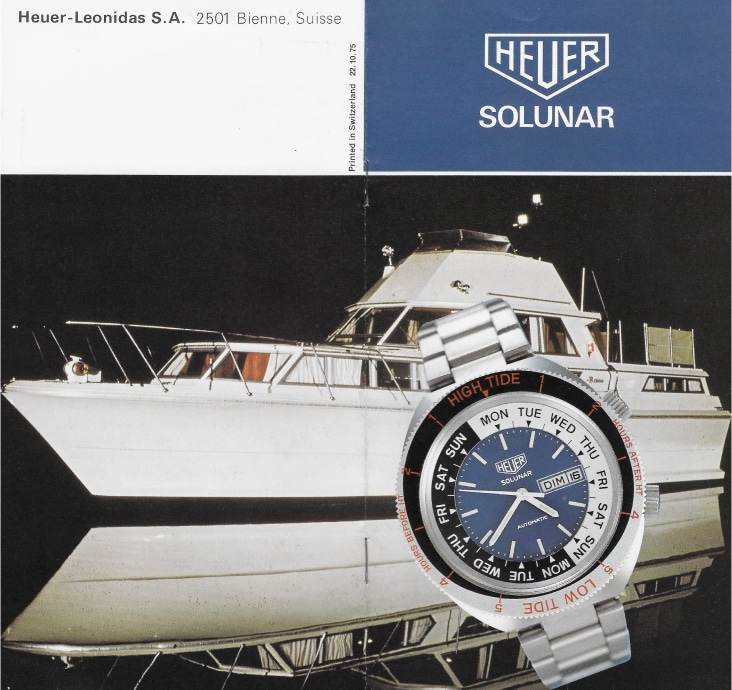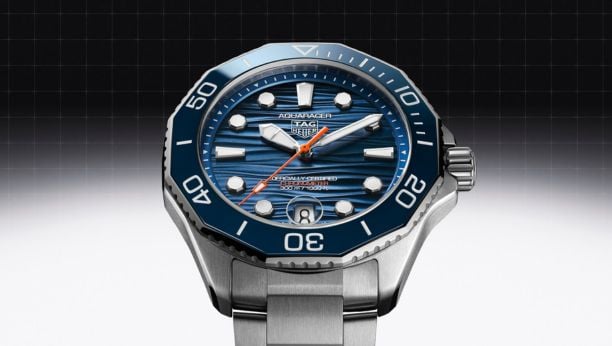VINTAGE Collection
THE HEUER SOLUNAR
As the only watch being made by Heuer in an era when its catalogs were dominated by chronographs, the Solunar was a unique timepiece. in Heuer’s 1970s collection. Even though it was not a chronograph, however, Heuer’s development of the Solunar was consistent with its position in offering “tool watches” that were purpose-built for outdoors people and adventurers. The prominent inner and outer bezels served as essential tools for those needing to know the times of the high and low tides and gave the Solunar a unique look which was consistent with the style of Heuer’s 1970s chronographs.
If in fact “form follows function”, then we can understand the unique look of the Heuer Solunar watch from the 1970s as a natural outgrowth of its very unusual complication, the watch being designed to indicate the high and low tides at a specific location for each day over a two-week period. Launched in 1975, the Solunar (the name being a portmanteau of “Solar” and “Lunar”) was aimed at fishermen, but its tide indication would be useful for anyone needing to track the tides, whether for surfing, shelling, or building the ultimate sand sculpture. The Solunar is a fascinating example of both niche marketing and how a watch can be used for much more than simply telling the time.

1949 SOLUNAR
The story of the Solunar watch begins in the late 1940s, in the era when Heuer was producing watches, chronographs and other timepieces for U. S. retailer Abercrombie & Fitch on a private-label basis. Jack Heuer recounts the story of the origins of the Solunar in his biography:
“One day my father came home from work and said that Walter Haynes, who was then the president of upmarket sporting outfitters Abercrombie & Fitch in New York, had asked him to create a watch which could display the time of tides. Funnily enough, some years earlier my father had thought it would be useful to have a watch that showed the phases of the moon because while mushroom hunting he had observed that morels seemed to spring up in greater numbers during a waxing moon, but a watch that could display the time of tides really stumped him. He had not seen the sea for quite a few years and was not at all familiar with the subject of tides. He scratched his head and admitted he had no idea how to do it. I told my father that my physics teacher at school, Dr Heinz Schilt, was a genius and I was sure he would be able to find a solution. Indeed he could and he performed all the calculations for the wheels and cogs needed for a watch to predict high tides at a given location.”
The success of the Solunar led to a Chronograph version of the tide watch, called the Heuer “Mareograph”. The chronograph combined the tide dial from the Solunar (positioned at 9 o’clock) with a three register chronograph, having 12 hour capacity. This chronograph was sold by Abercrombie & Fitch under the name “Seafarer” and later by Orvis under the name “Solunagraph”, but all these models were made by Heuer.
While the Mareograph range continued through to the 1970s, the Solunar disappeared from the Heuer range after being made for only a few years, until being revived in a very different form.

Arriving in 1975, the second-generation Solunar (reference 279.603) was an oddity in the Heuer Catalogue (shown in the 1977 Catalogue above), with its large (45mm) stainless steel case, dual-crown, Day-date window at 3 o’clock and lack of Chronograph complication. There was only one version of the new Solunar, and it featured a deep blue dial with painted luminous markers for the hours.

The design of the Solunar is dominated by the large external Black and Silver bezel (with its “High Tide” and “Low Tide” markings) and the internal two-week black and white internal bezel (marked for 14 days). These indicators take up most of the available real estate, leaving the blue dial itself looking relatively small.
The white-painted hands with luminous inserts are similar to the style used by Heuer for some of its mid-1970s chronographs, helping to give the Solunar a Heuer-family appearance. Similar in style to the Calculator chronograph, the Black colour and text on the bezel is printed on a silver base, rather than having an aluminium or steel insert.
The case itself has a high-shine polished finish, which provides an interesting contrast with the matte silver of the bezel. Topping off the watch is a domed plexi crystal- again, also similar to the design used on the Heuer Calculator.
The Solunar was available on either a stainless steel bracelet or the style of “Tropic” strap so often used for dive watches in the 1970s.
MOVEMENT
Powering the Solunar is an ETA 2790-1 movement, a Calibre that like the Solunar itself, was only produced for a few years between 1976 and 1980. It marks one of the first times that Heuer used an ETA branded movement, rather than movements from other brands in the ETA family, such as Valjoux and Landeron. The calibre offers not only a day-date function, but also a dual-language option for the day disc.
HOW IT WORKS

So, given that the Solunar has a conventional 3-hand movement, how does it indicate high and low tide? The answer lies in the combination of the internal two-week disc and the outer-bezel.
1. TWO-WEEK DISC
Before examining the operation of the Solunar watch, we begin with a refresher on the forces that affect the timing of the high and low tides. Tides are created by the gravitational pull between the earth and the moon. The timing of high tide is driven by two factors- the rotation of the earth (one rotation every 24 hours) and the moon rotating around the earth (once every ~28 days). If the moon did not move, then high tide would be the same time every day, but life is not that easy.
Given that we have two moving objects, the time of high tide moves each day by (1/28 X 24)= 51.5 minutes (approx.). Now take a look at the bezel - we have 14 days marked over a 12-hour dial. Applying a little more math:
(12 hours/ 14 days) X 60 minutes = 51.42 minutes between each triangular marker; indeed, close to the 51.5 minutes calculated above (let’s be honest- being a few seconds late or early for high tide is unlikely to change whether the fish are biting).
OK, so now that we know why the day markers are spaced approximately 51 minutes apart, how do you use the inner disc? Let’s say that your fishing holiday starts on a Monday and you have used the local tide charts to see that the first high tide of the day will be at 10:00 AM. Simply use the lower crown to rotate the inner disc so that the small triangle below the “MON” lines up with the time for the first high tide of the day (10:00) and that’s it. The black and white disc now indicates the high tide for each day over the next two weeks – if Monday’s first high tide will be at 10:00, then Tuesday’s will be at around 10:50 and Wednesday is at 11:40, and so it will continue for the two weeks.
This is helpful, but high tide does not only occur once a day - it occurs twice. So that is why we need a second scale, which Heuer placed on the outer bezel
2. OUTER BEZEL
The outer bezel shows that there is approximately 6 hours between high and low tide, and therefore 12 hours between high tides.
Simply moving the Red triangle on the bezel to the time of High Time (recall: 10.00 in the example shown) now gives you the daily ebb and flow of the tides.









